EQUIPMENT PROFILE
AIWA XK-S9000 CASSETTE DECK
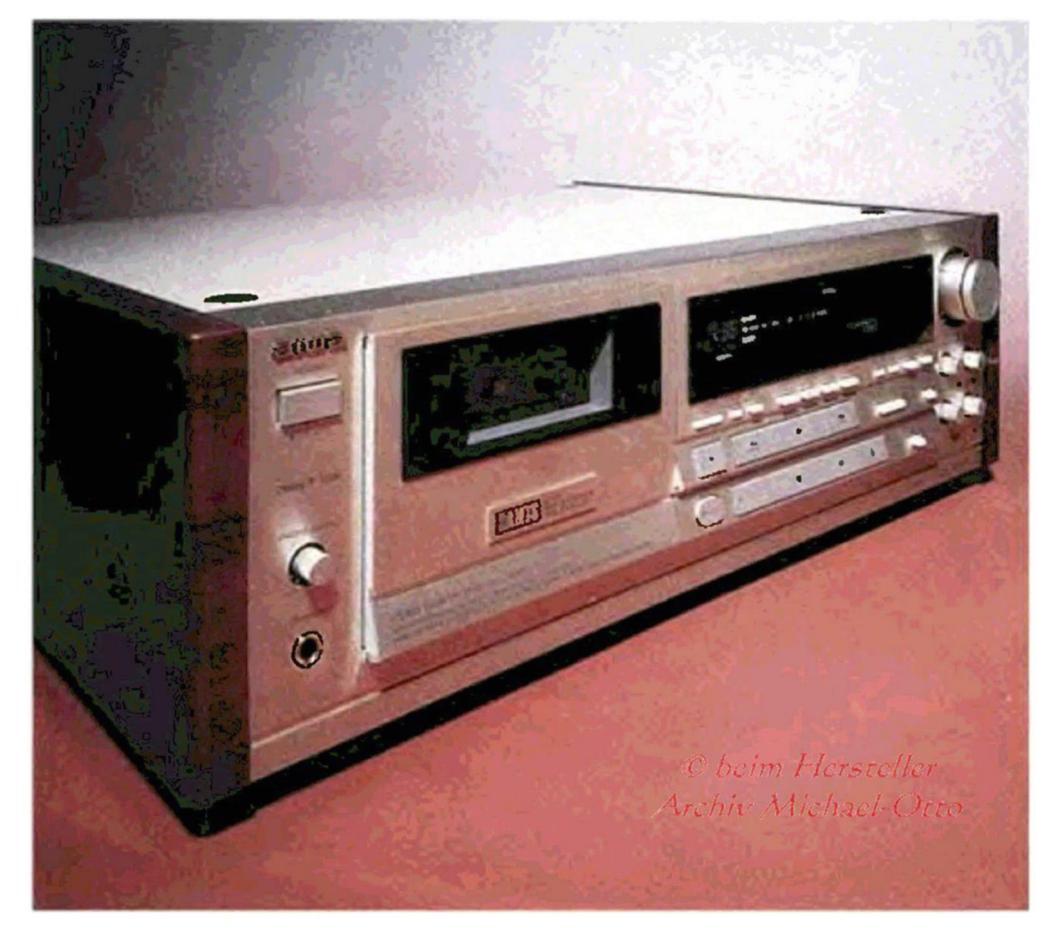
guess it's a sign a product genre has attained ultimate maturity when you find a model that does just about everything you've ever asked that product category to do-and does it very, very well. Such is the Aiwa XK-$9000, which, overlooking a few minor foibles, comes as close to being the ultimate cassette deck as any I've seen. When you total up the goodies, the options, and the things this deck does that others do not. the XK-S9000 also may rank as the ultimate bargain in cassette decks.
Needless to say, the XK-S9000 has Dolby B- and C-type noise reduction. What deck doesn't? But it also sports Dolby S NR. Although introduced some years ago, this noise-reduction system has elicited a rather limited following, possibly because a deck must meet stringent performance standarde-vis-à-vis azimuth alignment, tave matching facilities, etc .--- to be granted a Dolby S license. To top it off, a Dolby S
chip set (in this case, manufactured by Sony) is more expensive than a simple Dolby B/C chip. But with Dolby S noise reduction and a top-grade tape, cassette dynamic range can approach that of CD or DAT, so Dolby S NR is a system devoutly to be wished for.
Like a number of today's decks, the Aiwa XK-S9000 also features Dolby HX Pro headroom extension. Unlike many of those decks, the XK-S9000 lets you defeat the HX Pro system if you wish. Frankly, I've seen HX Pro implemented so poorly on so many decks that I've become quite leerv of the system. However, Aiwa has implemented it so well on the XK-S9000 that I found I wanted to use it and began complaining that HX Pro was one of the few options whose status is not indicated on the display nanel and whose button has such a short throw that it was hard for me to tell whether the system was on or off. (I must have something to complain about!)
Have you ever wanted to do live recording on cassette? At one time, you could; most decks had microphone inputs, albeit few had adequate mike preamps. Even rudimentary inputs went bye-bye years ago, presumably as an economy measure. So it's a bit of a surprise these days to find a deck that not only has a microphone input but a decent mike preamp as well.
Aiwa to the rescue. The XK-S9000 has unbalanced (phone jack) mike inputs and two small slide switches on the rear panel. One switch selects between the line and mi-
SPECS
Tape Section
Frequency Response (±3 dB): 13 Hz to 24 kHz with Type IV tape: to 22 kHz with Type II tape and to 21 kHz with Type I tape. S/N Ratio (With Type IV Tape, re Peak Level): 87 dB with Dolby S NR 65 dB with NR off.
Wow & Flutter: 0.018% wtd. rms, ± 0.035% wtd. peak.
D/A Section
Frequency Response: 4 Hz to 20 kHz, ±0.3 dB. Distortion (EIAI): 0.002% at 1 kHz. S/N Ratio (EIAI): 105 dB at 1 kHz. Dynamic Range (EIAJ): 95 dB at 1 kHz.
Channel Separation (EIAI): 100 dB at 1 kHz
General Specifications
Input Sensitivity: Analog, 50 mV; coaxial digital, 500 mV; optical digital, -18 dBm.
Input Impedance: Analog, 47 kilohms; coaxial digital, 75 ohms.
Output Level: Line, 530 mV at 0 VII into 47 kilohms or higher; headphone, 1.5 mW into 32 ohms.
Power Consumption: 33 watts. Dimensions: 181/2 in. W × 515/16 in.
H × 16% in. D (46.9 cm × 15.1 cm × 41.5 cm).
Weight: 30.8 lbs. (14 kg).
Price: $999.
Company Address: 800 Corporate Dr., Mahwah, N.I. 07430. For literature, circle No. 90
crophone inputs; the other adjusts mike preamp gain. In the more sensitive setting, a DIN-0 recording (that is, a flux level of 250 nWb/m at 315 Hz) can be attained with as little as 1.6 mV of output from the mike; in the less sensitive setting, 4.7 mV are required. The preamp's clipping point is 112 mV with the more sensitive setting and 330 mV when the gain is reduced. These figures compare with 85 mV needed from the line inputs for a DIN-0 recording. Input impedance on all analog inputs is perfectly adequate.
I say analog inputs because the Aiwa XK-S9000 also has coaxial and optical digital inputs and an internal digital-to-analog converter (DAC). The DAC is activated by a rear-panel slide switch adjacent to the
THE AIWA XK-S9000 COMES AS CLOSE TO BEING THE ULTIMATE CASSETTE DECK AS ANYTHING I'VE SEEN.
digital inputs: you can switch it off entirely when you're not using it, thereby preventing the possibility of clock noise getting into the analog circuitry. The recording source ("Line/Mic" or "Digital") and digital input ("Optical" or "Coax") are selected by front-panel switches. The DAC automatically adapts to the data rate: 32 kHz for digital broadcasts and some DATs, 44.1 kHz for CD and prerecorded DATs, and 48 kHz for home-recorded DATs. The chip is billed as a dual-channel, 18-bit device fed by an eight-times oversampled digital filter.
Apparently a "ladder" DAC is used, because my bench tests revealed substantial low-level nonlinearity on the left channel; this usually is caused by misadjustment of the most significant bit of the ladder. An adjustment error such as this can vary from unit to unit, so another sample might not exhibit the same problem.
More about test results later. For now, let's stay with features and general performance. Most cassette decks have a headphone output; few have a headphone level control, without which it becomes a matter of luck whether the volume is satisfactory. Aiwa fills the bill with a well-designed
headphone amplifier whose output impedance (54 ohms) is aimed at delivering maximum level into typical consumer headphones. (Maximum power transfer is achieved when the headphone impedance matches the source impedance.)
The XK-S9000's four-motor transport is, without question, the quietest I've experienced. When the cassette is loaded (this happens automatically when the cassette is dropped into the door slot), it is clamped against a resilient pad to damp shell vibration. To optimize torque characteristics during recording and playback and yet provide fast tape spooling, different motors drive the reels in fast-wind and in normal record/play modes. The pancake-type d.c. servo motor, which operates the dual-capstan drive, is on a floating mount to reduce transmission of vibration, and a fourth motor is activated to operate the door. This deck's speed accuracy is stellar and is independent (of/line voltage, fastwind times are reasonably swift and record/play wow and flutter is well below average.
Adding to the impression of solidity and quiet competence are the XK-S9000's resonance-deadening wooden base with oversize feet. high-gloss simulated-rosewood side panels, and twin toroidal power transformers-one for the analog circuitry, one for the digitaleach extending outside the rear panel. More important from the performance standpoint is the ultra-stiff headbase casting that is mounted on three points to increase stability and reduce resonance. Finally, a head stabilizer is used to reduce vibration of the head assembly itself.
The recording and playback sections seem to be well shielded from each other. Each uses an amorphous core wound with "stressfree ultra-pure 6N" copper. The erase head is built around a double-gap Sendust core.
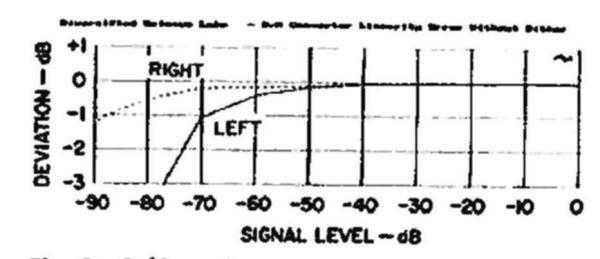
Fig. 1—D/A section deviation from linearity.

Fig. 2—Record/play THD + N vs. frequency at -10 dB.

Table I—Input and output characteristics for DIN 0 recorded level.
|
Imp.,
Ohms S |
LEVEL | |||
|---|---|---|---|---|
| Input | Sens. | Clipping | ||
| Line | 2 | 5k | 85 mV | >10 V |
| Mike | 5.35k | 1.6 mV | 112 mV | |
|
Mike, with
attenuator |
4.7 mV | 330 mV | ||
| Imp., | LEVEL | _ Load, | ||
|
Output
Line |
Ohms
1,090 |
Unloaded
865 mV |
Loaded | Ohms |
| Headphone | 54 | 5.44 V |
4.75 V
(37.6 mW |
600
) |
|
1.89 V
(71 mW) |
50 | |||
Table II-Record/play S/N ratios (re DIN 0) with CCIR/ARM and IEC A weightings.
| $/N, d B | |||
|---|---|---|---|
| CCIR/ARM Wtd. | Type I | Type II | Type IV |
| Without NR | 54.6 | 59.7 | 57.1 |
| With Dolby B NR | 64.9 | 69.8 | 67.4 |
| With Dolby C NR | 74.3 | 78.5 | 76.5 |
| With Dolby S NR | 77.5 | 81.7 | 79.6 |
| A-Weighted | |||
| Without NR | 57.3 | 62.0 | 59.7 |
| With Dolby B NR | 66.5 | 70.6 | 68.6 |
| With Dolby C NR | 74.4 | 77.5 | 76.0 |
| With Dolby S NR | 76.7 | 80.3 | 79.2 |

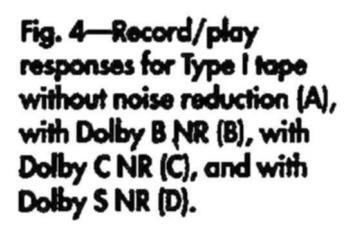
The display has dual, 24-segment, peaklevel indicators calibrated from -40 dB (which is always on) to +14 dB. The indicator responds very quickly (in about 0.4 mS) and without overshoot; the cursor decays in about 0.5 S, making it easy to read. A peak-hold mode can be activated to capture the maximum reading.
Fig. 5—Record/play responses for Type II tape without noise reduction (A), with Dolby B NR (B), with Dolby C NR (C), and with Dolby S NR (D).
The deck automatically detects the type of tape via the keyways on today's cassette shells, and sets equalization and bias accordingly. Each change of tape is indicated on the display by a change of tape-type indication and of suggested maximum recording level (+6 for "Normal," +8 for "CrO2," and +10 for "Metal"). The display
also shows Dolby NR setting (B, C, or S) and "Monitor" position ("Source" or "Tape").
Although the XK-S9000 automatically sets bias and equalization for the generic type of tape being used, you can tweak it for the particular brand you're using. These adjustments are made with four controls arranged just under the "Record Level" pot. One knob switches the calibration system on and off and, when on, increases the indicator sensitivity to display signal level in 0.5-dB increments. A second knob adjusts bias, a third adjusts recording sensitivity to ensure proper Dolby tracking, and the fourth (more on it in a moment) adjusts recording equalization.
Aiwa uses 400-Hz and 10kHz test tones for setup. The high-frequency signal appears on the upper (left-channel) level indicator; the 400-Hz signal appears on the lower (rightchannel) level indicator. You adjust bias and record sensitivity until both level indicators hit red tick marks that appear on the display when the deck is in the calibration mode.
The fourth knob has an unusual and quite interesting function. It permits you to modify the recording equalization by ±2 dB at 10 kHz prior to adjusting bias and recording sensitivity. This means you can adjust the balance between a tape's low-frequency maximum operating level (MOL) and its high-frequency saturation operating level (SOL) to fit the characteristics of the music
that you're recording and still maintain flat frequency response. For example, if you're recording classical music, which is likely to have substantial bass and midrange energy but relatively moderate treble levels, you can switch "Rec EQ" to "High" before adjusting bias and record sensitivity. This will give you a bit more low-frequency

Fig. 6—Record/play responses for Type IV tape without noise reduction (A), with Dolby B NR (B), with Dolby C NR (C), and with Dolby S NR (D).
headroom at the sacrifice of a tad of highfrequency headroom. For synthesized music with a lot of surrealistic highs, you might want to switch "Rec EQ" to "Low," to augment high-frequency headroom at the expense of low. Either way, you still get flat frequency response and proper Dolby tracking, because "Bias" and "Rec Sensitiv-
ity" are set after the recording equalization is modified.
Another novelty on this deck is Aiwa's Blank Tape Optimized Recording (BTOR) system. There are two record buttons on the front panel, one marked "Rec" and the other "B-Rec." With "B-Rec." the erase head is deactivated since it's not needed with virgin or bulkerased tape. Aiwa claims that the "result is well-dampened sound. sound expansion, less distortion, and clear sound reproduction." In my bench tests. I could find no statistically significant difference in background noise between the two recording modes (the factor that should be influenced most directly by erase-head performance). However, when I switched modes, matters didn't deteriorate either, and you can switch between modes without recalibrating bias and sensitivity, which suggests that Aiwa's bias supply is rock solid and insensitive to changes in loading.
On the more traditional front, the Aiwa XK-59000 has a quasireal-time tabe counter (with memory for rewinding to counter zero) with a blinking warning when you're within 3 minutes of the end of the side, a multi-function display (all display functions active, only the tape counter active, all display functions defeated), a defeatable MPX filter, a record mute, and timer-operated record and playback with a play/repeat option. The remote control can be used to open and close the door, reset the counter, enable counter memory, toggle through the display choices, operate the transport (rewind/review, play, fast forward/cue, record (but not B-Rec), stop, and pause), and activate record mute. Aiwa's instruction manual could be improved, es-
pecially the section on calibration and the effect of the "Rec EQ" switch.
Measurements
Obviously, a deck with this many options necessitated a good bit of testing, and I generated reams of data. Because it's not
feasible to present all of it here, I have cherry-picked the most significant graphs.
Let's start with the D/A converter, which was measured to the deck's line output jacks with "Monitor" in the "Source" position and the record level adjusted to produce a 2-V output. (This methodology was followed to separate converter performance from deck performance.)
THIS DECK HAS IT ALL, FROM DOLBY S NR TO A BUILT-IN D/A CONVERTER.
The low-level nonlinearity on the D/A converter's left channel, which I mentioned earlier (see Fig. 1, made with undithered signals) also showed up as increased third-, fifth-, and seventh-harmonic distortion on the -60 dB, 1-kHz tone. As a result, the left channel's EIAJ dynamic range, which is based on this test, was only 91.5 dB, while the right-channel figure was 2.6 dB better. at 94.1 dB. Aside from this, however, the converter acouitted itself reasonably well. It doesn't pretend to be the equal of a standalone DAC, and one can question its purpose in an analog cassette deck when every digital program source I can think of has its own DAC and could be duplicated in the analog domain. But if you view it as a freebie, how can you complain? Frequency response was within +0, -0.1 dB from 20 Hz to 20 kHz on both channels: interchannel phase error was $1.75° over the same band. The THD + N at 0 level was less than 0.005% from 20 Hz to beyond 3 kHz, rose to 0.01% at 6 kHz, and peaked at 0.064% at 18 kHz. Channel separation was better than 60 dB at all frequencies below 10 kHz. The deck's A-weighted noise was -100.3 dB. and its quantization noise was -89.3 dB.
For my testing of analog record/play, the tapes I used were all from TDK. Aiwa shipped the review sample with TDK AD, SA, and MA in C-46 lengths. I substituted TDK DS-X for AD (which no longer is available in this country) and used C-90 tapes for all testing.
The deck's input sensitivity, overload points, output levels, and input and output
impedances (see Table I) impressed me as being well chosen. The XK-S9000 should therefore interface readily with other normal equipment.
When recording, indicator readings for a DIN-0 level (250 nWb/m) are +3 to +4 on the scale; distortion at DIN 0, while setting no new records, was reasonably low, espe-
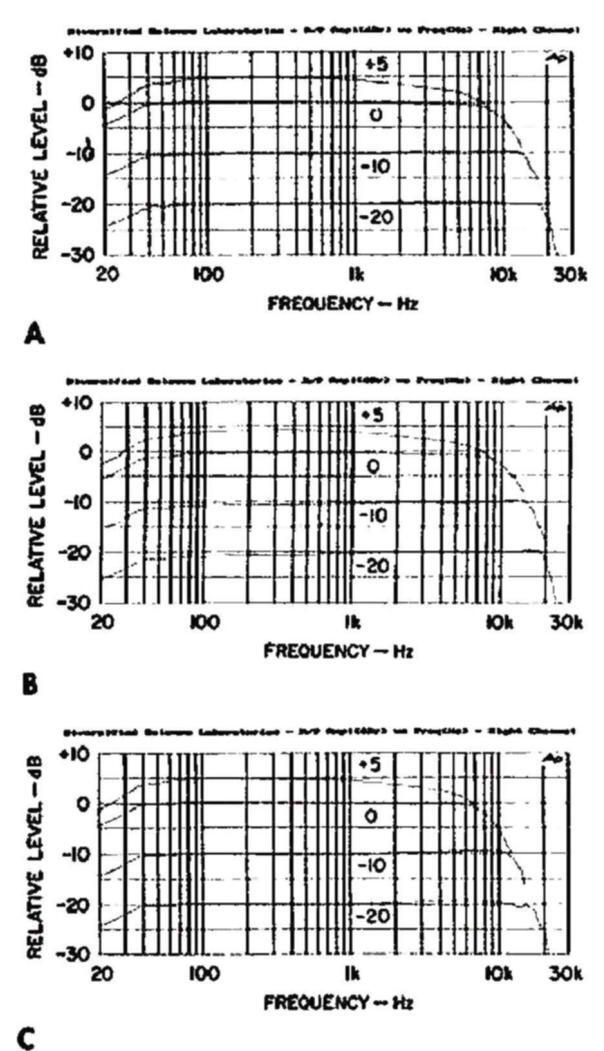
Fig. 7—Record/play responses for Type I tape, without noise reduction, at "Norm," (A), "Low" (B), and "High" (C) record equalization settings.
cially with the Type I tape: Results were 0.79% for Type I, 1.7% for Type II, and 1.2% for Type IV. Recording limits for 3% THD + N were +5.0 dB for Type I, +2.2 dB for Type II, and +4.8 dB for Type IV. Figure 2 shows THD + N versus frequency at 10 dB below DIN 0. The maxima range from 1% to 1.5%, depending on tape formulation—results which, while not outstanding in my experience, are nonetheless perfectly respectable.
Record/play channel separation at 315 Hz was 46.1 dB, which is par for the course in the analog cassette world. Erasure of a high-level 100-Hz signal on Type IV tape (always the worst case) was a very impressive 73.5 dB.
Noise levels for the record/play cycle are shown in Table II. Those measured with CCIR/ARM weighting show the usual progressive 10-dB improvements when going from recordings made without Dolby NR, to those with Dolby B NR, to those with Dolby C NR. The S-type system reduces CCIR/ARM noise by another 3.25 dB, but the audible improvement was greater than this number suggests; Dolby S is the only Dolby NR system that is effective in the bass as well as in the treble; it yields a theoretical 10-dB reduction in low-frequency noise and a 24-dB improvement in highfrequency noise (4 dB greater than Dolby C NR in the treble). Using CCIR/ARM weighting shows the treble improvement but practically ignores low-frequency noise, so the difference there doesn't show up in the measurement. Using A-weighting tilts the scale even further against demonstrating the relative improvement with Dolby S noise reduction. The A-weighted figures are tabulated for comparison and because these are the ones recognized by the EIA Standard.
Record/play interchannel phase error (8.8°, ±5.1°) was quite low, testifying to careful relative alignment of the recording and playback head sections. Interchannel phase error measured when playing the BASF 70-µS calibration tape was extremely low, which tes-
tifies that Aiwa's quality control department did its job in aligning the heads to the standard tape. This shows up in playback response as well (Fig. 3). Left-channel response is down a mere 0.5 dB at 10 kHz, 1 dB at 16 kHz, 1.9 dB at 18 kHz, and 3.4 dB at 20 kHz on the Type II BASF tape; results are 0.5 dB, 1.5 dB, 2.1 dB, and 3.9 dB (respectively) on the Type I BASF tape. The right channel was generally within 0.5 dB of the left on each tape.
I measured record/play response at four levels (--20, -10, 0, and +5 dB), on each channel, with each tape, with each choice of noise reduction, and with HX Pro on and off—almost 100 curves in all. Frequently, HX Pro causes an unnatural rise in high-frequency response. That is not the case with the Aiwa XK-S9000, which is unusual in that it is as well behaved with HX Pro as without. I was so impressed, I am showing the results only with HX Pro and, to simplify matters further, only for the right channel (without noise reduction and with Dolby B, C, and S NR) in Figs. 4, 5, and 6.
The above curves were taken with the "Rec EQ" switch set at "Norm." Figures 7 and 8 are the response curves taken without Dolby noise reduction, on Type I and Type IV tape, at each record equalization setting. (Results for changing equalization with Type II are not shown, because they were very similar to those with Type I.) Finally, to illustrate the change in MOL and SOL that the different "Rec EQ" options effect, Fig. 9 shows SOL versus frequency, from 3 to 20 kHz, for Type I and Type IV tape at each setting. (Effects on Type II, not shown, were similar to those on Type I.) Figure 10 shows THD + N versus recorded
WITH DOLBY S NOISE REDUCTION, CASSETTE DYNAMIC RANGE CAN APPROACH THAT OF CD OR DAT.
level at 315 Hz for each EQ setting on Type I tapes; the differences were less pronounced on Type II and IV tapes and therefore are not shown. Some of the curves in Fig. 10 appear jagged because I chose to plot THD + N against recorded (tape playback) level rather than recording (input) level; variations in playback level cause the jaggedness.
As to mechanical characteristics, playback speed error was only +0.1% for line voltages from 105 to 127 V, and record/ play wow and flutter was +0.035%. With a C-90 tape, fast-forward time was 102 S, and rewind time was 98 S.

without noise reduction a "Norm," (A), "Low" (B), and "High" (C) record equalization settings.
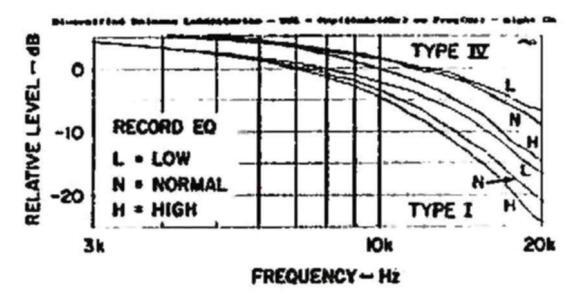
Fig. 9—Effect of record EQ on SOL for Type I and Type IV tapes.
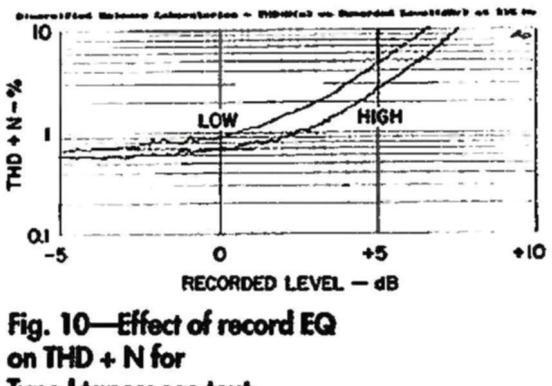
Type I tapes; see text.
Use and Listening Tests
I gave the story away at the beginning of this review. The Aiwa XK-S9000 is the most "compleat" cassette deck I've seen-and one of the best performing. But that won't prevent me from nitpicking a few details, some of which are more a matter of personal preference rather than of right and wrong. For example, some people prefer to have the tape counter reset itself when the cassette is ejected: others prefer that the count be held so you can open and close the door without losing it. The Aiwa XK-S9000 adopts the latter approach.
From an ergonomic standpoint. just about every setting is shown either on the display or by illuminated dots on the transport controls. (The major exceptions are the settings for HX Pro and the MPX filter.) However, the suggested maximum recording level marks (+6 for Type I, +8 for Type II, and +10 for Type IV) are rather ambitious for the 70-uS tapes and overly conservative for the Type I (120-uS) product. Bench measurements suggest that levels 2 dB lower would be more appropriate for TDK SA and MA, while DS-X can be pushed close to +10.
When calibrating the deck, clockwise rotation of "Rec Sensitivity" increases recording level and, thereby, increases the indication on the "Low Freq" (lower) portion of the display. Rotating "Bias" clockwise increases the bias current and thereby reduces the indication on the "High Freq" (upper) portion of the display. Although this makes sense to the technically inclined. I think the average user would prefer to have a clockwise rotation of "Bias" reduce the actual bias and thereby increase the indication. That way, you'd always turn the knob in the direction you want the indicator to go. and both "Bias" and "Rec Sensitivity" controls would operate in a similar way.
I would have preferred to have the line outputs muted in the calibration mode. The test tones appear at the line outputs and are audible at a rather high level, so it's best not to have volume up high when calibrating this deck. Also, if you calibrate for the particular tape you're using (the whole point of the calibration system), you can't use "B-Rec" because the calibration tones will have been recorded on the tape and will need to be erased.
Nitpicking aside, the Aiwa is an extraordinary cassette deck. It comes with a Dolby S sampler from Windham Hill that has to rate as one of the finest, if not the finest, prerecorded cassettes I've heard.
I recorded using all tape types and every NR option. Source material included CDs and personal digital recordings chosen to expose recording flaws that typically occur on cassette. Among the rock/pop CDs were Amanda McBroom's Dreaming (Gecko, no catalog number) and Tracy Chapman's Tracy Chapman (Elektra 9 60774-2). From the classics, I used pianist Richard Goode's Beethoven: The Late Sonatas (Elektra/Nonesuch 9 79211-2) and harpsichordist Colin Tilney's Scarlatti Sonatas (Dorian DOR-90103). My recordings were of piano and harpsichord, particularly difficult to record because their transients can be easily and audibly mutilated
I will not claim that I could hear no difference between source and copy using Dolby S noise reduction and a direct A/B comparison, but the differences were very slight; without direct comparison, I think few audiophiles would complain of the tape version if they thought it was a CD. This was especially true when using the Type I tape, whose smoothness in response and tonal character were very impressive. Dolby S NR made residual noise inaudible at normal listening and recording levels on all three tape types, so there is no reason to forgo a good Type I product with this deck. Recordings made with Dolby C NR were nearly as good on this deck (especially when using Type II tape), although Dolby S NR maintains the edge.
With DCC and MD in the wings, is Aiwa's XK-S9000 the swan song of the analog cassette genre? It's hard not to pose the question. But the Aiwa's scope is so broad and its performance so exemplary that posing it makes me sad. Edward J. Foster






